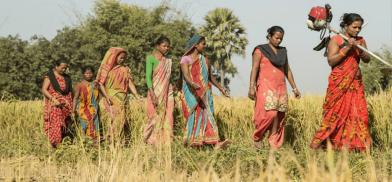Nepalis eating less due to lockdown hardships
A survey gauging the impact of COVID-19 on Nepali households has revealed that nearly a quarter of families in Nepal are eating less, and 6% said they had run out of food

A survey gauging the impact of COVID-19 on Nepali households has revealed that nearly a quarter of families in Nepal are eating less, and 6% said they had run out of food.
The Livelihoods, Food Security and Vulnerability Survey Report conducted last month by the Ministry of Agriculture with support from the World Food Programme (WFP) and Australian Aid singled out three provinces: Far-Western, Karnali and Province 2 as the most vulnerable.
The survey was carried out by phone among a nationally representative sample of 4,416 households in all seven provinces, and concludes that the pandemic and lockdown have made Nepal’s fragile food security situation worse.
The Nepal Demographic and Health Survey four years ago had showed that 4.6 million people suffer from inadequate food, and 10% of those families were severely food insecure. The new survey indicates that households in rural areas are more likely to be food-insecure than people living in urban areas during the lockdown because food prices tend to be higher there.
It showed 7% of households had poor dietary diversity leading to malnutrition, which represents an increase of 2% compared to previous surveys. Children and women were the most vulnerable with nearly half the babies up to two years suffering from a lack Minimum Dietary Diversity. Most of these children were in the three provinces.
The main reason for greater food insecurity was the loss of jobs due to the economic crisis induced by the COVID-19 lockdown. One out of 10 households in the survey said they had lost at least one source of income in the month previously, with the highest rate of job loss in Province 5. Families in Karnali and Far-west also had income losses, with Gandaki Province suffering the least from loss of livelihoods.
The group most impacted by food shortages are daily wage labourers and female-headed households. A quarter of non-farm labourers said they had lost their income sources, and 11% of daily wage workers in farms said they had lost their jobs.
The reduction in income was most acute among households with a migrant worker, those with a family member who needed medical treatment and those dependant on market purchases of food items. The most impacted by livelihood were daily wage earners both on-farm and off-farm.
Of those surveyed 55% required to buy food from the market, while 44% grew and consumed their own food. Although three out of every four households surveyed said they had enough food stocks, 42% of those who said they had enough only had enough food to last a month.
Half of the households in the phone survey who said they did not have enough food said the reason was lack of money, followed by a shortage of food in the market and restricted access to markets because of the lockdown.
‘The fact that many households rely on markets for their food highlights a potential risk of deepening vulnerability, given that the COVID-19 crisis has resulted in broader losses of income in Nepal,’ the report concludes. ‘This could be further exacerbated when households’ food stocks are depleted, affecting those with existing vulnerabilities as well as other parts of the population that would be normally less vulnerable.’
https://www.nepalitimes.com/latest/nepalis-eating-less-due-to-lockdown-hardships/









Post a Comment